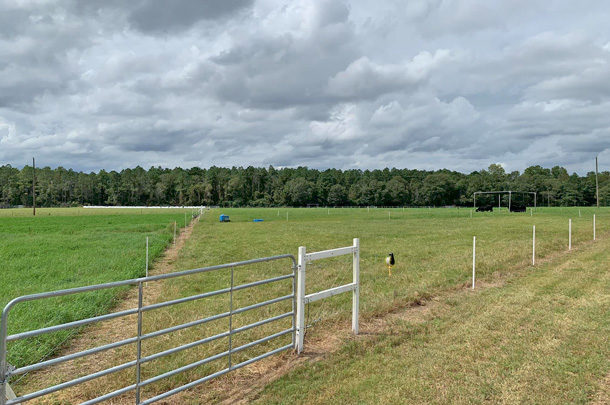Hello spring, sunshine, nice warm days, blooming clovers and lush green grasses. Hello also, grownup roadsides and deep-green cover crops and hayfields full of volunteer grazeable forage – except we can’t graze these areas; they don’t have a fence. Or, can we?
Having pulled more than a few strands of barbed-wire, smooth-wire and woven-wire fence in my life, I understand how the idea of additional fencing in an area not primarily used for grazing could deter anyone from utilizing cover crop, row crop or hayfields. Often times, these areas are sprayed or mechanically harvested to remove residues prior to the next season. But, what if we used multiple four-legged harvesters rather than the four-wheeled type to manage this area?
The advent of temporary and permanent electric fencing technologies has made implementing grazing, even in alternative locations (non-fenced areas) about as easy as taking a walk across your field. In fact, it’s so easy, and positive benefits to the land and livestock are so great, it’s almost crazy not to do it.
Temporary fencing technology involves the utilization of non-permanent, easy-to-handle and mobilize tread-in posts, polywire or polytape, fence handles, and a charger or energizer. There are many options for temporary posts available, and from experience, everyone has a favorite for a multitude of reasons – mine being ease of step-in due to my small feet and ease of lowering or adjusting the fence without getting shocked. When grazing non-pastureland, temporary fencing is a good alternative to allow short-term confinement of animals, as it is easy to handle and requires minimum effort for maximum grazing benefit.
Note that electricity is a must for extended animal containment, as animals respect this type of fencing because of the shock factor. If you do not have the option of connecting onto an existing electric fence, there are solar energizers that can very effectively electrify your temporary system, but be sure to properly ground the system with fence and ground leads and a grounding rod.
Fencing problem areas
Another common problem area that could be grazed if only it could be properly fenced are wet, rough or steep terrains where installation of standard wooden or steel t-posts seems nearly impossible. Just getting to these areas is challenging enough, and managing them with periodic grazing would be of great benefit, if we had a good fence option. The advent of permanent plastic posts has changed the game. No longer do we have to be concerned about posts rotting, rusting or shorting our electric fence in these challenging areas. While there are many temporary plastic posts available, there are now permanent posts on the market with long-term (20-year) warranties that are also lighter weight and easier to handle and install than standard permanent-post options.
Additionally, these types of posts do not require insulators, as they are not made of conductive material to pull current away from the wire, and they have natural flexibility, which can be very beneficial when fencing in or around wooded locations with lots of limbs or high wildlife activity.
So, the next time you’re out enjoying the welcoming beauty of spring and admiring the popping clovers and flowing green grass wishing you could graze it – consider some of these new fencing technologies and turn that “no we can’t” to “yes we can.”
If you find yourself in South Georgia and are curious about seeing some of these new technologies in use, visit the fencing and watering systems demonstration as part of the “Better Grazing Program Southern Location” on the UGA-Tifton Campus. The Better Grazing program is an extension and research demonstration location focused on the implementation and utilization of technologies to improve grazing with strong internal and external local, regional and national support from industry, extension, and forage- and livestock-focused commodity groups.









